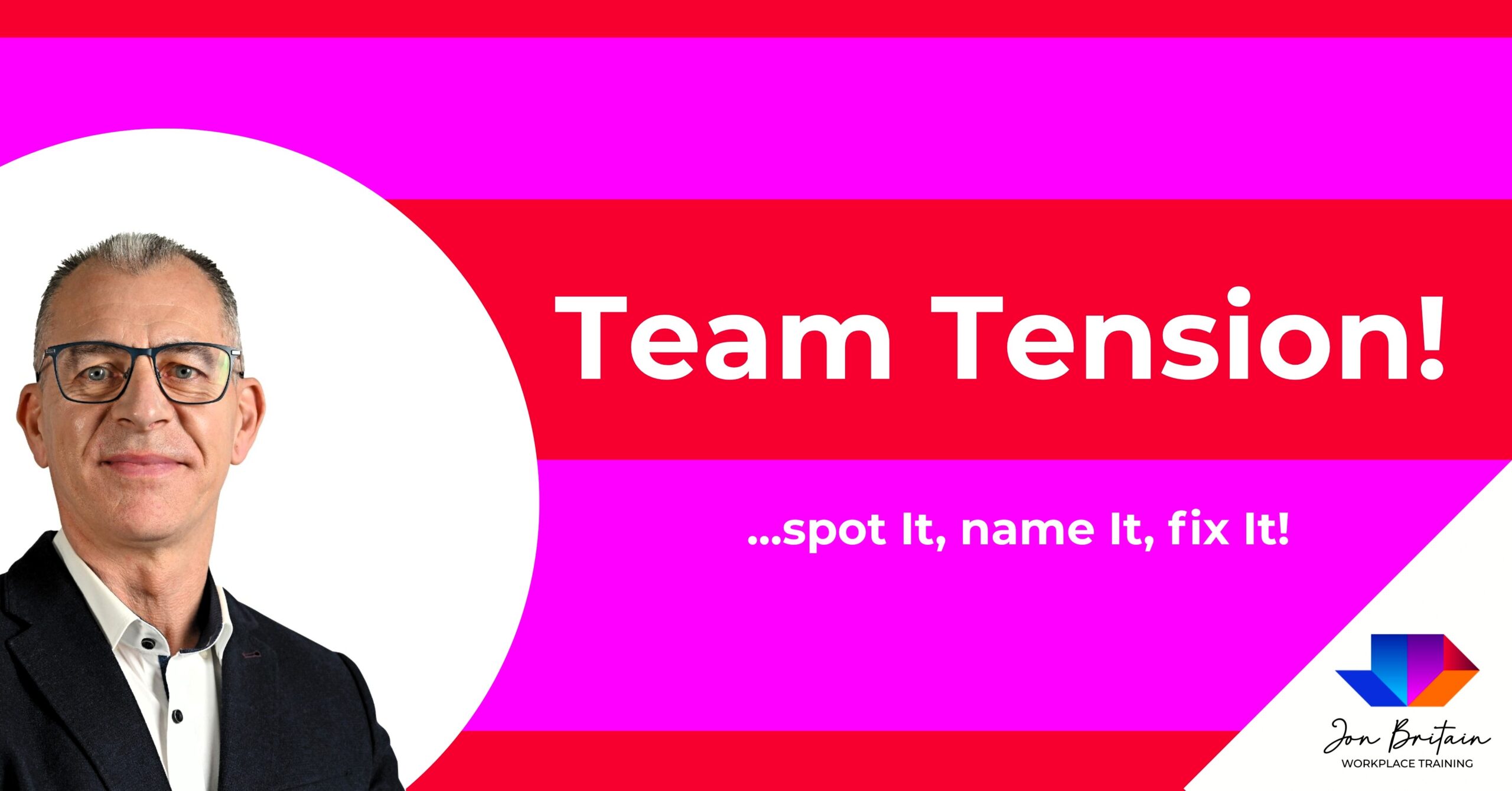🤐 Team Tension: Spot It, Name It, Fix It!
Tension in teams doesn’t always look like raised voices or fiery debates.
More often, it sounds like… nothing at all.
I recall one meeting vividly, people nodded, scribbled a few notes, and then headed back to their desks.
Nobody said what they really thought.
You could feel the tension, but no one was naming it, actually saying it out loud
A few days later, sarcasm had crept in. Energy was low, and that’s when it hit me.
Tension wasn’t the problem. It was the silence around it that caused damage.
If you want a switched-on, connected team, you’ve got to spot the tension, say it out loud, and take action.
❌ Where Team Tension Hides
Forget shouting matches; most team tension hides in plain sight. It’s the low-key stuff you see every day:
- The eye-rolls
- Colleagues “going along” with things they disagree with
- People avoid each other
- Silence when you know there should be conversation
It may not appear to be a conflict, but it’s wearing people down.
When people can’t speak up or disagree safely, they shut down.
And that’s when team culture starts to crack.
When people are afraid to speak up, don’t know how to bring up difficult topics, or are trying to keep the peace, but it can cause problems to fester.
🧠 A Framework That Works: The Five Behaviours
This is where The Five Behaviours, based on Patrick Lencioni’s work, comes in.
It’s a simple model, but it gets right to the heart of what makes teams work (or not).
Let’s focus on the first two steps:
🔹 Trust
🔹 Conflict
They’re linked. Strong teams don’t avoid conflict; they’ve built enough trust to handle it well.
🔹 Trust: The Real Kind
Not “I trust you to hit deadlines” trust.
We’re talking about vulnerability-based trust, the kind that sounds like:
- “I dropped the ball.”
- “I’m struggling with this.”
- “I need help.”
When people feel safe enough to be real, you stop getting masks and start getting meaningful input.
🔹 Conflict: Not a Dirty Word
Lecioni says that if you do not have conflict, you have ‘false harmony’
Once trust is established, conflict no longer feels dangerous.
It becomes useful. Even healthy.
Good conflict gives you:
- Better decisions (because people actually challenge ideas)
- Faster progress (less dancing around the issues)
- More buy-in (because everyone’s been heard)
This is what we call productive conflict.
Not arguing for the sake of it, but honest conversations that move things forward.
🚨 The Real Problem? Most Teams Avoid It
Here’s the big myth:
“Polite” teams are healthy teams.
Not always.
Most people avoid conflict because they think it’ll upset the team.
But burying tension doesn’t fix it. It just pushes it underground, where it turns into:
- Gossip
- Passive resistance
- Missed ideas
- Quiet resentment
Ever heard someone say, “I’ll just keep my mouth shut”?
That’s not harmony, that’s trouble waiting to happen.
🔍 How to Spot Hidden Tension
You don’t need a psychology degree, pay attention to the signs:
✅ No one challenges ideas
✅ “Real” conversations happen after the meeting
✅ Roles and accountability are murky
✅ Feedback is rare or sugar-coated
✅ The team avoids decisions or drags them out
✅ The mood is flat
These are red flags. And they’re usually pointing to something unspoken.
🗣️ Name It to Tame It
This is your game-changing move as a leader:
Call it out. Gently. Clearly. Early.
Try something like:
- “It feels like we’re skimming the surface. What’s not being said?”
- “It’s okay to disagree. What’s your honest view?”
- “I sense a bit of tension, let’s talk about what might be going on.”
You’re not solving it for them, you’re making it okay to talk about it together.
🔧 So, How Do You Fix It?
You don’t need to tear everything down and start again.
Just start with a few key moves.
- Show Some Vulnerability Yourself
Go first. Be real. Say:
- “I got this wrong.”
- “I’m not sure what the best approach is here.”
- “I’d love your take, I might be missing something.”
It creates a ripple effect.
- Encourage Honest Conversation
Say things like:
- “Let’s get the awkward stuff on the table now, not later.”
- “If you disagree, I want to hear it.”
Invite a challenge. Make it normal.
- Make Conflict Safe, Not Scary
Use a framework like The Five Behaviours to teach what good conflict looks like.
Praise people for speaking up, even if their views differ from yours.
- Address Issues While They’re Small
Don’t let frustration build.
If something feels off, discuss it early, before it becomes more complicated.
💬 What Productive Conflict Sounds Like
You know things are on the right track when you hear phrases like:
- “I see it a bit differently, can I share why?”
- “I don’t agree, but I’m open to being convinced.”
- “Before we decide, can we talk through this concern?”
- “I’m not 100% comfortable. Can we dig into that?”
That’s not confrontation.
That’s clarity. Respect. Progress.
💡 Try This in Your Next Team Meeting
Before diving into tasks, ask your team:
🟡 “What’s one thing we’re not talking about but probably should?”
🟡 “Where might we be too polite for our good?”
🟡 “What would help us be more open with each other?”
Yes, it takes guts. But it can completely shift the mood in the room.
🙌 Culture Shifts Start With Conversation
If your team feels tense, flat, or disconnected, don’t jump straight to more processes, rules, or team-building days.
Start with:
✅ A bit more trust
✅ A bit more courage
✅ And a lot more real conversation
The best teams aren’t free of conflict.
They’re just not afraid of it.
🚀 Want Some Help?
I work with teams (and their leaders) to build a culture where people feel safe, heard, and motivated to do great work.
Using The Five Behaviours, I help teams:
- Build deep, real trust
- Tackle tough topics early and honestly
- Make better decisions, faster
- Create shared goals that people actually commit to
- Focus on collective results, not just individual wins
🟨 It all starts with one conversation. If you’re ready to have it, I’m ready to help!

Helping managers fix team tension
#TheFiveBehaviours #TeamCulture #ProductiveConflict #TeamTension #LeadershipDevelopment #HonestConversations #TrustMatters




